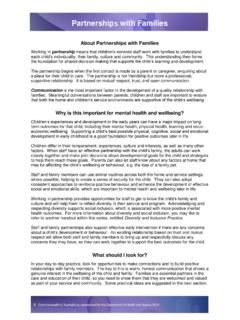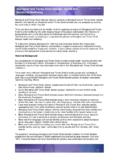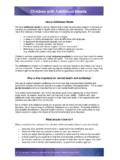Transcription of Child Abuse and Mental Health - Response Ability
1 Response Ability Child Abuse and Mental Health Abuse can occur in any relationship or context. The main focus of this material will be Abuse in childhood or adolescence, but it is important to remember that adults can also experience abusive relationships. This fact sheet has a particular focus on links between Child Abuse and Mental Health problems or disorders. Types of Abuse Physical Abuse - physical injury resulting from practices such as punching, beating, kicking, biting, or burning. Physical injury may occur in single or repeated episodes. It can range in severity from minor bruising to death. Neglect - harm or endangerment as a result of failing to provide for the Child 's basic needs, by providing inadequate nutrition, clothing, hygiene or supervision.
2 Unlike other forms of Abuse , it is an act of omission by the caregiver, which jeopardizes or impairs the Child 's physical, intellectual or emotional development. Sexual Abuse - when an adult or older person uses his or her power over a Child to involve the Child in sexual activity. The abuser may trick, threaten, or force a Child to take part in sexual activity. Child sexual Abuse may include suggestive behaviour or comments, exposure or exhibition of the genitals, fondling genitals, masturbation, oral sex and penetration. Emotional Abuse - a behavioural pattern in which a parent or caregiver repeatedly attacks a Child 's self-esteem and social competence over time.
3 The Child may be constantly told that they are worthless, rejected and shown no affection, subjected to repeated verbal threats and severe punishments and restricted from contact with others. This is sometimes called psychological Abuse . Domestic Violence a situation where a Child is a witness to or involved in violent family disputes, including physical, verbal or sexual Abuse toward any member of the family. Exposure to domestic violence is considered a reason for notification of Child Abuse under legislation in NSW. Other states may recognise it within the category of psychological Abuse . Multi-type maltreatment - the interaction of different types of Abuse may be more predictive of the Child 's outcome than only looking at one type of Abuse .
4 Generally when one form of Child Abuse exists, then the Child will also be either exposed to, or at risk of, other forms of Abuse . If Abuse occurs frequently and severely, then the Child is likely to have poorer outcomes in regard to his or her Health and wellbeing. Prevalence of Abuse It is difficult to estimate the true prevalence of Child Abuse in the community. Each state has different legislation or guidelines in regard to reporting Abuse and may classify forms of Abuse slightly differently, especially where multiple forms occur together. In the financial year 2003-04, over 200,000 cases of Abuse were reported to state and territory welfare departments.
5 Within this figure, some children were the subject of notification more than once in any year, so there will be a higher number of notifications than children involved. However it is also likely that there were many other cases of Child Abuse in the community that were never reported to the authorities. The prevalence of exposure to domestic violence is also difficult to determine. It is likely that much domestic violence goes unreported, and exposure to domestic violence is not necessarily reported for inclusion in Child Abuse figures. A national survey of 5,000 Australian teenagers, reported in 2001, found that one quarter had witnessed domestic violence against a female parent.
6 Commonwealth of Australia 2005 1. Response Ability Various forms of Abuse and domestic violence often occur together. A Victorian study reviewed the case files of 50 children who had experienced serious Abuse most had experienced more than one form of Abuse in terms of physical, neglect, sexual and emotional/psychological Abuse . 42% of the children had experienced elements of all four forms of Abuse . In addition, the above study looked for other forms of violence that might exist in these family environments. A large proportion of the children had been exposed to some form of domestic violence between the household's parents or carers most commonly verbal, but also physical, psychological or sexual.
7 In addition, many of these families also featured Abuse against other children, or violence between siblings. Risk Factors for Child Abuse There are some factors or circumstances that are known to increase the risk of Child Abuse , although not all families who have these risk factors will go on to Abuse their children. There is a higher risk of Abuse and violence in some disadvantaged families that have experienced multiple social and financial problems. However it is important not to stereotype families or make assumptions about their relationships on this basis. It is also important to realise that Abuse can occur in families that do not appear to fit this profile.
8 Risk factors for Child Abuse include: Lack of parenting skills and knowledge in the parent or caregiver Poor interpersonal skills, coping skills, self-esteem or self-control in the parent or caregiver Teenage or early pregnancy and lack of support Low socio-economic status including unemployment, homelessness, poverty Family problems such as domestic violence, substance use, family breakdown, criminal activity Health problems in the parent or caregiver, such as chronic ill Health , physical or Mental illness Health or behaviour problems in the Child , such as chronic ill Health , difficult behaviour, low birth weight, disability, developmental delay or impairment History of intergenerational Abuse .
9 Warning Signs of Abuse There are warning signs that suggest the possibility of Abuse . However it is important to remember that the presence of these signs does not necessarily mean that Abuse has occurred. Some of these can also represent behaviour or Mental Health problems which have arisen for reasons other than Abuse . Telling people about the Abuse , directly or indirectly (eg in a poem or drawing). Physical signs of being beaten or abused, such as bruising, broken bones Sexual behaviour inappropriate or too precocious for the Child 's age Teenage pregnancy, promiscuity or sexually-transmitted diseases Self-destructive behaviour, substance use or risk taking behaviour Externalising problems such as disruptive or aggressive behaviour, bullying Internalising problems such as withdrawal, anxiety, depression, guilt, distrust Mental illness such as depression, anxiety disorders or eating disorders Self-harm or suicidal behaviour, threats of suicide Commonwealth of Australia 2005 2.
10 Response Ability Child Abuse and Mental Health Experiencing Abuse in childhood or adolescence has been identified as a significant risk factor for poor Mental Health , poor attachment and connection to parents and family, and general adjustment problems. Certain children may be less vulnerable to such problems following Abuse or neglect, if there are other factors that offset these effects. Such protective factors include connectedness to other members of the family or peers, minimal other life stress, level of development and resilience prior to Abuse , and the availability of resources, intervention and support programs. Effects on General Mental Health Adjustment in later life varies and will be affected by factors such as age of Child when abused, severity, frequency and duration of Abuse .











